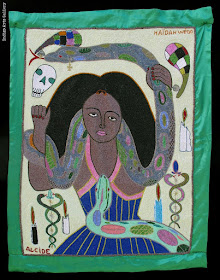 |
Images from Indigo Arts Gallery
(click any image to enlarge)
|
Vodou flags are a mixture of French battle flags with West African bead work. They feature beads and sequins. Originally they were religious in intent, although with the growth of tourism to Haiti they have also adopted a more secular and commercial purpose. From Haitianna's article Vodou Flags - An Essay on Collecting:
As Vodou flags made their way out of temples and into Port-au-Prince galleries and the hands of foreign buyers, curiosity about their purpose and function grew along with the numbers of people making flags. Some artists like Georges Valris imbue their flags with Christian imagery such as angels. Valris , who denies any belief in voodoo, regards flag-making as a commercial enterprise. Other flag makers, including Jean Baptiste Jean Joseph, are diehard voodooists. He once told me a story about seeing the mermaid figure of La Sirene, who controls the fate of anyone dealing with the ocean, actually walking out of the sea. But Joseph is also practical, using the flag medium in documentary fashion to portray what he sees around him including cats and lizards. This broad range of pictorial representation makes him a welcome anomaly among the current crop of voodoo flag makers, a group whose numbers seem to be swelling in recent years. With his innate color sense and use of luxurious materials such as velvet and satin, Joseph is setting a high standard for the next generation of flag makers to follow.These examples, and those after the jump, are from Indigo Arts Gallery's catalog of Haitian Vodou Flags. They sell the flags (as well as artwork from other regions) if you're interested in purchasing one.
Each flag maker is known for something special. For Yves Telemaque, it’s the fantastic and optically challenging borders of his flags. By surrounding the central image in triangles and circles, then using faux pearls to accentuate contrasting colors, Telemaque rivals the paintings of Jasper Johns. Then there are traditionalists like Clotaire Bazile, who adheres to voodoo heritage in his portrayal of gods and goddesses and their symbolism. His simple diamond borders recall the careful workmanship on American patchwork quilts. Even newcomers to the field are distinguishing themselves. Lerisson Dubreus uses the trapunto technique of his forebears who made flags half a century and more ago.

















No comments:
Post a Comment